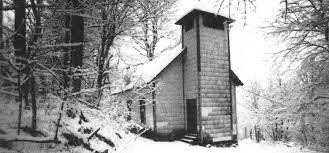Boone Methodist Episcopal Church
The Boone Methodist Episcopal Church, also called the Boone Chapel Church, was founded in the early 1890s as a church home for the Black community of Boone. The church building was constructed by two local Black carpenters.1 In its early years, the church was the largest and most prominent church in the Junaluska community. A majority of the community was involved in the church and considered it an important aspect of their lives.2
Many events and activities were hosted at the Methodist Episcopal Church including men’s Bible study, a women’s missionary circle, and others. There were also regularly scheduled Youth Group and Choir meetings. At one point, the church also functioned as a school for African American children, filling a gap when no other schools were available. The Methodist Episcopal Church often collaborated with the Boone Mennonite Brethren Church in the mid-twentieth century. The churches coordinated to hold services at different times in order to allow people to attend both churches. Both churches became an intertwined and significant part of the Junaluska community due to their hospitality collaboration.3
Membership at the Methodist Episcopal Church began to decline in the 1930s and 1940s. The Horton, Haigler, and Folk families anchored the church during its successful days. In 1932, brothers Ralph and Norwood Horton were lynched by a white mob, leading many of the Horton family members to move to Philadelphia. Following the tragedy, more families left both the church and the Junaluska community.4 During World War Two, many men in the community were drafted, which also depleted the church’s membership. Between the 1940s and the 1980s, the church was served by a circuit preacher rather than a full-time minister. This meant that services were only held a few times a month. During this period, membership at the Boone Mennonite Brethren Church, also in Junaluska, grew. In 1989, The Boone Methodist Episcopal Church was declared inactive by the United Methodist Church, and shuttered its doors.5
Once the church officially closed, the building fell into disrepair due to a lack of maintenance. The town of Boone condemned the church in 1993 and a second time in 1995. After many failed efforts by the Junaluska community and concerned members of the faculty at Appalachian State University to recover and preserve the church, it was demolished in 1995.6

The Boone Methodist Episcopal Church
“Boone Methodist Episcopal Church,” Junaluska Heritage Association, https://junaluskaboone.org/.
Bibliography
Keefe, Susan and Manross, Jodie. “Race, Religion, and Community: The Demolition of a Black Church.” Appalachian Journal. Spring Vol. 26, No 3. (1999): 252-263.
Keefe, Susan. Junaluska: Oral Histories of a Black Appalachian Community. Jefferson NC: McFarland. 2020.
-
Susan Keefe, Junaluska: Oral Histories of a Black Appalachian Community, Jefferson NC: McFarland, 2020. 19. ↩︎
-
Sandra Haigler, Interview by Susan Keefe (2012), Junaluska: Oral Histories of a Black Appalachian Community, Jefferson NC: McFarland, 2020. 153. ↩︎
-
Susan Keefe and Jodie Manross, “Race, Religion, and Community: The Demolition of a Black Church,” Appalachian Journal, Spring, Vol. 26, No 3, (1999), 254. ↩︎
-
Susan Keefe, 17-18, 24. ↩︎
-
Susan Keefe and Jodie Manross, 255. ↩︎
-
Susan Keefe and Jodie Manross, 259-260. ↩︎